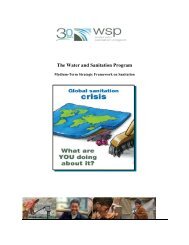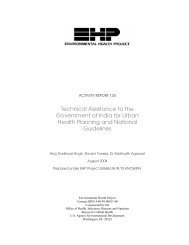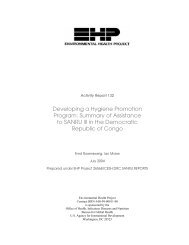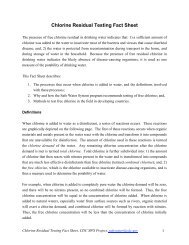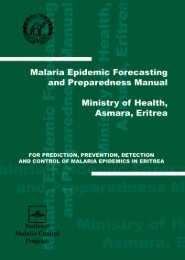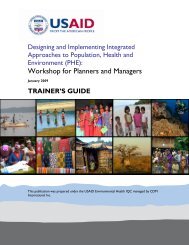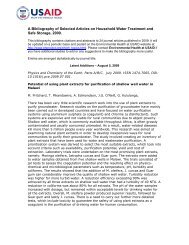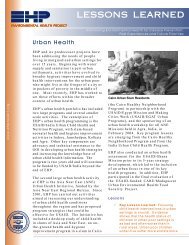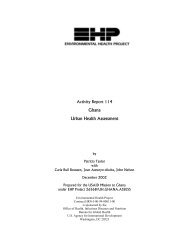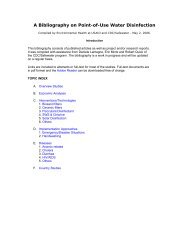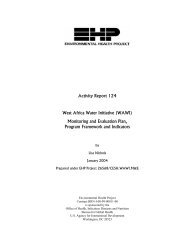Changing Glaciers and Hydrology in Asia - Environmental Health at ...
Changing Glaciers and Hydrology in Asia - Environmental Health at ...
Changing Glaciers and Hydrology in Asia - Environmental Health at ...
- No tags were found...
You also want an ePaper? Increase the reach of your titles
YUMPU automatically turns print PDFs into web optimized ePapers that Google loves.
EXECUTIVE SUMMARYThe United St<strong>at</strong>es Agency for Intern<strong>at</strong>ional Development’s (USAID’s) <strong>Asia</strong> Bureau, with supportfrom the Global <strong>Health</strong> Bureau, conducted a series of stakeholder <strong>and</strong> expert dialogues <strong>in</strong> 2009with the Woodrow Wilson Intern<strong>at</strong>ional Center for Scholars entitled “<strong>Asia</strong>’s Future: CriticalTh<strong>in</strong>k<strong>in</strong>g for a <strong>Chang<strong>in</strong>g</strong> Environment.” The dialogues identified <strong>and</strong> explored issues th<strong>at</strong> willshape conditions <strong>in</strong> <strong>Asia</strong> dur<strong>in</strong>g the 21 st century. One of the issues identified was clim<strong>at</strong>e change,<strong>and</strong> <strong>Asia</strong>’s high-mounta<strong>in</strong> glaciers were a focal po<strong>in</strong>t of discussions. The <strong>Asia</strong> Bureau realized aneed to underst<strong>and</strong> better the science <strong>and</strong> implic<strong>at</strong>ions of glacier retre<strong>at</strong> <strong>and</strong> to assist Missions<strong>in</strong> plann<strong>in</strong>g <strong>and</strong> programm<strong>in</strong>g new fund<strong>in</strong>g th<strong>at</strong> is targeted to address the impacts of glacier melt<strong>in</strong> the high mounta<strong>in</strong>s of <strong>Asia</strong>. USAID <strong>in</strong>iti<strong>at</strong>ed a project, led <strong>and</strong> managed by CDM Intern<strong>at</strong>ional,Inc., th<strong>at</strong> undertook the follow<strong>in</strong>g tasks:Review the science concern<strong>in</strong>g glacier melt <strong>in</strong> <strong>Asia</strong>.Identify key glacier melt vulnerabilities <strong>in</strong> the <strong>Asia</strong> region.Identify organiz<strong>at</strong>ions contribut<strong>in</strong>g to address<strong>in</strong>g glacier melt <strong>and</strong> its impacts <strong>in</strong> <strong>Asia</strong>.Develop str<strong>at</strong>egic cross-sectoral responses to these vulnerabilities, <strong>in</strong>clud<strong>in</strong>g responsesth<strong>at</strong> provide multiple benefits.The geographic focus of this study is on the region of “High <strong>Asia</strong>” (see the map on the cover),sometimes referred to as the Gre<strong>at</strong>er Himalayan region, <strong>and</strong> the countries whose river w<strong>at</strong>ersflow from High <strong>Asia</strong>. High <strong>Asia</strong> <strong>in</strong>cludes the Himalaya, H<strong>in</strong>du Kush, Karakoram, Pamir, <strong>and</strong> TienShan mounta<strong>in</strong> ranges, where current glacier coverage exists.The Scientific PerspectiveAlthough the world’s glaciers have been retre<strong>at</strong><strong>in</strong>g slowly s<strong>in</strong>ce the Little Ice Age (approxim<strong>at</strong>ely1650 to 1850), recent clim<strong>at</strong>e warm<strong>in</strong>g has acceler<strong>at</strong>ed the r<strong>at</strong>e of retre<strong>at</strong>. However, glaciersystems <strong>at</strong> the highest elev<strong>at</strong>ions, 4000-7000 m – like those <strong>in</strong> High <strong>Asia</strong> – have not respondedto recent clim<strong>at</strong>e warm<strong>in</strong>g <strong>in</strong> the same way as lower elev<strong>at</strong>ion glaciers, simply because higherelev<strong>at</strong>ionglaciers currently rema<strong>in</strong> below freez<strong>in</strong>g dur<strong>in</strong>g much of the year, even <strong>in</strong> the presenceof a warmer clim<strong>at</strong>e.Long-term, comprehensive d<strong>at</strong>a for the remote glacierized areas of the Himalaya do not exist,so r<strong>at</strong>es of retre<strong>at</strong> are not known over the whole region. Field measurements are often, bynecessity, limited to a few local measurements on easily accessible glaciers, typically <strong>at</strong> the lowerelev<strong>at</strong>ions. More recently, measurements over larger areas are becom<strong>in</strong>g available utiliz<strong>in</strong>gs<strong>at</strong>ellite remote sens<strong>in</strong>g—but often lack<strong>in</strong>g historical basel<strong>in</strong>es. Historical glacier d<strong>at</strong>a from theHimalaya <strong>and</strong> adjacent mounta<strong>in</strong> ranges are limited mostly to term<strong>in</strong>us loc<strong>at</strong>ion measurements.These are problem<strong>at</strong>ic because they only show th<strong>at</strong> the ice <strong>at</strong> the term<strong>in</strong>us is melt<strong>in</strong>g faster thanthe r<strong>at</strong>e <strong>at</strong> which ice is be<strong>in</strong>g supplied to th<strong>at</strong> loc<strong>at</strong>ion by movement (dynamics) of ice fromfurther upslope <strong>in</strong> the system. A glacier might ga<strong>in</strong> total mass from one year to the next (from<strong>in</strong>creas<strong>in</strong>g amounts of snow arriv<strong>in</strong>g <strong>at</strong> the higher elev<strong>at</strong>ions), while the term<strong>in</strong>us, <strong>at</strong> the lowest1



